Contrasting Stakeholders’ Perceptions of Pine Plantations in the Páramo Ecosystem of Ecuador
Abstract
1. Introduction
2. Materials and Methods
2.1. Study Area
2.2. Methodology
3. Results
3.1. Stakeholder Classification
- Landowners; this group was represented by property owners or land managers with primary decision-making authority for the property. The properties included pine plantations located in the highlands of South Ecuador.
- Local governments; this group was represented by representatives from the Juntas Parroquiales Rurales, the autonomous local governments decentralized from the central government; they are in charge of the protection and sustainable use of the environment and the biodiversity of their jurisdiction. For this reason, they have to promote plans and programs of conservation, afforestation, reforestation, and other actions tending towards the fulfillment of this objective. Additionally, local governments have to coordinate environmental management with other entities (public and/or private) and prevent the generation of conflicts derived from inadequate management of natural resources. For this study, we considered only local governments from territories with pine plantations (established in private properties) in the páramos of southern Ecuador.
- Foresters; this group was represented by forestry professionals and forestry researchers working for public institutions, private organizations or companies, and universities. Of the public institutions, we selected the national and regional forestry departments, which are the entities in charge of promoting and regulating commercial forestation activities. The private companies consisted of timber companies and others that specialized in the establishment of plantations for climate change mitigation and the sustainable management of plantations. The universities included were involved in research and education. All of them were involved in activities in the páramos.
- Nature conservationists; this group was represented by researchers and professionals engaged in the conservation of natural resources from both the public and private sectors or universities. From the public institutions we included the national department that is in charge of forest restoration. The private institutions considered were specialized in research, managements and conservation of the páramo ecosystem. Some of them were international NGOs that had local representation.
3.2. Information Collected in the Interviews
3.2.1. Characteristics and Management of the Plantations
3.2.2. Motivation for the Establishment of Plantations
3.2.3. Stakeholder Perceptions of the Land Condition Previous to Afforestation
3.2.4. Stakeholder Perceptions of the Impacts Caused by Pine Plantations
3.2.5. Future Plantations
4. Discussion
5. Conclusions
- Scientific evidence should be the starting point to reconcile the different perceptions between the stakeholders. Therefore, foresters and nature conservationists should communicate the results and nature of their research with the other stakeholders [66].
- The local knowledge provided by the perceptions of the landowners was fundamental [67] to identify gaps of knowledge related to the ES of provisioning wood and supporting habitat (wildlife refuge for animals).
- Perceptions among stakeholders differ on several aspects, such as: wood production, water regulation and supply, and support of habitat. Even within stakeholder groups, perceptions were not uniform on topics such as the regulation of erosion prevention and the maintenance of soil fertility. This disparate views should be reconciled by more interaction between stakeholders, which will facilitate linkage and information flow [68].
- Because wood production has been the main objective for the establishment of pine plantations in the páramo, their management must be improved; for example by establishing the plantations in lands designated for forestation, providing financial plans and silvicultural treatment, ensuring adequate road access to plantations and the fair commercialization of wood.
- It is quite unlikely that the emission-reduction objectives intended in the contracts can be achieved, especially for the plantations located in higher altitudes. Furthermore, it must be noted that the plantations may have negative effects on the provision of other ESs, such as supporting habitats for native species and regulating water flows. Consequently, the establishment of new plantations should take into account these possible trade-offs [5,69].
Author Contributions
Funding
Acknowledgments
Conflicts of Interest
Appendix A
Appendix A.1. Interviews Applied to Landowners
Appendix A.2. Interviews Applied to Local Governments, Foresters and Nature Conservationists
- ¿Conoce cuándo se realizaron las primeras plantaciones de plantas exóticas (pino), y cuál fue el motivo (reforestación, producción de madera, protección del suelo, etc.)?
- ¿Cuáles fueron los criterios para seleccionar a esta especie? ¿Por qué no se tomaron en cuenta otras especies?
- ¿Se consideraron otras especies? ¿Cuáles?
- ¿Cuál es la procedencia de los plantines, por qué se escogió esta procedencia?
- ¿Qué tipo de terrenos se seleccionaron para las plantaciones, hubo algún tipo de preparación del terreno antes de la plantación?
- ¿Bajo qué marco legal se están manejando las plantaciones, qué tipo de convenios existen, quienes son los responsables, qué tipo de regulaciones existen?
- En la actualidad, ¿cuáles serían los impactos positivos que se han generado gracias a las plantaciones? (ambientales, económicos, sociales)
- ¿Cuáles serían los principales impactos negativos, y qué medidas se han tomado o se están tomando? (ambientales, económicos y sociales)
- ¿Cuál es el objetivo de manejo de las plantaciones forestales (protección, producción, secuestro CO2, etc.)?
- ¿Qué actividades se planifica realizar en los próximos años? (tipo de manejo, estudios, etc…)
- A la institución a la cual usted representa, ¿cuáles son los aspectos que más le interesan, respecto a las plantaciones (pino)? (estudios, ventajas/desventajas, protección, producción, captura carbono, reintroducción especies nativas, etc.)
- ¿Cuáles son las desventajas que se presentan a futuro para las plantaciones (de pino)?
- ¿Cómo cree que las plantaciones se podrían mejorar y/o acelerar?
- ¿Cree que las plantaciones forestales podrían mejorar la situación económica de los propietarios, industrias forestales?
- ¿Cómo su institución podría mejorar esta situación, esta la institución activamente participando en este proceso o planea hacerlo?
- ¿Qué áreas deberían designarse para plantaciones forestales, y cuáles no? (especificar pino)
- ¿Apoya su institución el establecimiento de plantaciones forestales, con qué especies? (económicamente, asesoría técnica, pago por servicios ambientales, etc.)
References
- IUCN (International Union for Conservation of Nature). High Andean Wetlands; IUCN: Gland, Switzerland, 2002. [Google Scholar]
- Farley, K.A.; Anderson, W.G.; Bremer, L.L.; Harden, C.P. Compensation for ecosystem services: An evaluation of efforts to achieve conservation and development in Ecuadorian páramo grasslands. Environ. Conserv. 2011, 38, 393–405. [Google Scholar] [CrossRef]
- Crespo, P.; Celleri, R.; Buytaert, W.; Feyen, J. Land use change impacts on the hydrology of wet Andean páramo ecocystems. In Proceedings of the Workshop on Status and Perspectives of Hydrology in Small Basins, Goslar-Hahnenklee, Germany, 30 March–2 April 2009; Volume 6. [Google Scholar] [CrossRef]
- Hofstede, R.; Calles, J.; López, V.; Polanco, R.; Torres, F.; Ulloa, J.; Vásquez, A.; Cerra, M. Los Páramos Andinos ¿Qué sabemos? Estado de Conocimiento Sobre el Impacto del Cambio Climático en el Ecosistema Páramo; UICN: Quito, Ecuador, 2014; ISBN 978-9978-9932-9-3. [Google Scholar]
- Farley, K.A.; Bremer, L.L. “Water Is Life”: Local Perceptions of Páramo Grasslands and Land Management Strategies Associated with Payment for Ecosystem Services. Ann. Am. Assoc. Geogr. 2017, 107, 371–381. [Google Scholar] [CrossRef]
- Farley, K.A. Grasslands to tree plantations: Forest transition in the Andes of Ecuador. Ann. Assoc. Am. Geogr. 2007, 97, 755–771. [Google Scholar] [CrossRef]
- Farley, K.A. Pathways to forest transition: Local case studies from the Ecuadorian Andes. J. Lat. Am. Geogr. 2010, 9, 7–26. [Google Scholar] [CrossRef]
- Gade, D.W. Nature and Culture in the Andes; University of Wisconsin Press: Madison, WI, USA, 1999; ISBN 0299161242. [Google Scholar]
- Hofstede, R.; Groenendijk, J.; Coppus, R.; Fehse, J.; Sevink, J. Impact of Pine Plantations on Soils and Vegetation in the Ecuadorian High Andes. Mt. Res. Dev. 2002, 22, 159–167. [Google Scholar] [CrossRef]
- Farley, K.A.; Kelly, E.F.; Hofstede, R.G.M. Soil Organic Carbon and Water Retention after Conversion of Grasslands to Pine Plantations in the Ecuadorian Andes. Ecosystems 2004, 7, 729–739. [Google Scholar] [CrossRef]
- Farley, K.A.; Jobbagy, E.G.; Jackson, R.B.; Jobbágy, E.G.; Jackson, R.B. Effects of afforestation on water yield: A global synthesis with implications for policy. Glob. Chang. Biol. 2005, 11, 1565–1576. [Google Scholar] [CrossRef]
- Buytaert, W.; Iñiguez, V.; De Bièvre, B. The effects of afforestation and cultivation on water yield in the Andean páramo. For. Ecol. Manage. 2007, 251, 22–30. [Google Scholar] [CrossRef]
- Ochoa-Tocachi, B.F.; Buytaert, W.; De Bièvre, B.; Célleri, R.; Crespo, P.; Villacís, M.; Llerena, C.A.; Acosta, L.; Villazón, M.; Guallpa, M.; et al. Impacts of land use on the hydrological response of tropical Andean catchments. Hydrol. Process. 2016. [Google Scholar] [CrossRef]
- Merchán, N. Pinos destructores. El Mercurio. 17 November 2013. Available online: http://www.elmercurio.com.ec/405974-pinos-destructores/#.VW2mTaamTu1 (accessed on 28 November 2017).
- Granda, P. Monoculture Tree Plantations in Ecuador; World Rainforest Movement: Montevideo, Uruguay, 2006. [Google Scholar]
- Ramos, I.; Bonilla, N. Women, Communities and Plantations in Ecuador; Hersilia, F., Ed.; World Rainforest Movement: Montevideo, Uruguay, 2008; ISBN 978-9974-8030-6-0. [Google Scholar]
- Urgenson, L.S.; Prozesky, H.E. Stakeholder Perceptions of an Ecosystem Services Approach to ClearingInvasive Alien Plants on Private Land. Ecol. Soc. 2013, 18. [Google Scholar] [CrossRef]
- Gonzales, C.; Galindo, G.; Robles, M.; Rosero, E.; Sarango, O.; Velasco, C. Gobernanza Forestal en el Ecuador; The International Tropical Timber Organization (ITTO): Yokohama, Japan, 2011. [Google Scholar]
- Luteyn, J.L.; Churchill, S.P.; Griffin, D., III; Gradstein, S.R.; Sipman, H.J.M.; Gavilanes, A. Páramos: A Checklist of Plant Diversity, Geographical Distribution, and Botanical Literature; New York Botanical Garden: The Bronx, NY, USA, 1999; ISBN 0893274275. [Google Scholar]
- Mena-Vásconez, P.; Hofstede, R.; Vásconez, P.M.; Hofstede, R. Los páramos ecuatorianos. In Botánica Económica de los Andes Centrales; Mónica, M., Øllgaard, B., Kvist, L.P., Borchsenius, F., Balslev, H., Eds.; Universidad Mayor de San Andrés: La Paz, Bolivia, 2006; pp. 91–109. [Google Scholar]
- Hofstede, R.; Coppus, R.; Mena-Vásconez, P.; Segarra, P.; Wolf, J. The conservation status of tussock grass páramo in Ecuador. Ecotropicos 2002, 15, 3–18. [Google Scholar]
- Killeen, T.J.; Douglas, M.; Consiglio, T.; Jørgensen, P.M.; Mejia, J. Dry spots and wet spots in the Andean hotspot. J. Biogeogr. 2007, 34, 1357–1373. [Google Scholar] [CrossRef]
- Padrón, R.S.; Wilcox, B.P.; Crespo, P.; Célleri, R.; Padrón, R.S.; Wilcox, B.P.; Crespo, P.; Célleri, R. Rainfall in the Andean Páramo: New Insights from High-Resolution Monitoring in Southern Ecuador. J. Hydrometeorol. 2015, 16, 985–996. [Google Scholar] [CrossRef]
- Quichimbo, P.; Tenorio, G.; Borja, P.; Cardenas, I.; Crespo, P.; Celleri, R.; Cárdenas, I.; Crespo, P.; Célleri, R. Efectos sobre las propiedades físicas y químicas de los suelos por el cambio de la cobertura vegetal y uso del suelo: Páramo de Quimsacocha al sur del Ecuador. Suelos Ecuatoriales 2012, 42, 138–153. [Google Scholar]
- Dahlgren, R.; Shoji, S.; Nanzyo, M. Chapter 5 Mineralogical Characteristics of Volcanic Ash Soils. Dev. Soil Sci. 1993, 21, 101–143. [Google Scholar] [CrossRef]
- Hofstede, R.; Mondragon, M.; Rocha, C. Biomass of grazed, burned, and undisturbed páramo grasslands, Colombia. I. Aboveground vegetation. Art. Alp. Res. 1995, 27, 1–12. [Google Scholar] [CrossRef]
- Greiber, T.; Schiele, S. Governance of Ecosystem Services LECTURE. 2017; 140. [Google Scholar]
- Jokisch, B.D. Migration and Agricultural Change: The Case of Smallholder Agriculture in Highland Ecuador. Hum. Ecol. 2002, 30, 523–550. [Google Scholar] [CrossRef]
- Wunder, S.; Albán, M. Decentralized payments for environmental services: The cases of Pimampiro and PROFAFOR in Ecuador. Ecol. Econ. 2008, 65, 685–698. [Google Scholar] [CrossRef]
- Jara, L. PROFAFOR del Ecuador, S.A., Quito, Ecuador. Personal communication, 2017. [Google Scholar]
- INEC (InstitutoNacional de Estadística y Censos). VII Censo de Población y V de Vivienda; Resultados Definitivos Provinciales del Azuay y Cañar; INEC: Quito, Ecuador, 2010. [Google Scholar]
- Hidropaute, S. Paute Integral. Available online: https://www.celec.gob.ec/hidropaute/perfil-corporativo/paute-integral.html (accessed on 26 February 2018).
- Grimble, R.; Chan, M.-K. Stakeholder analysis for natural resource management in developing countries. Nat. Resour. Forum 1995, 19, 113–124. [Google Scholar] [CrossRef]
- Russell, B.H. Research Methods in Anthropology, 4th ed.; Rowman Altamira: Lanham, MD, USA, 2006; ISBN 978-0-7591-0868-4. [Google Scholar]
- Payne, G.; Payne, J. Key Concepts in Social Research; SAGE Publications, Ltd.: London, UK, 2004; ISBN 9780761965428. [Google Scholar]
- Pushpam, K. (Ed.) TEEB The Economics of Ecosystems and Biodiversity Ecological and Economic Foundations; Earthscan: London, UK; Washington, DC, USA, 2010. [Google Scholar]
- MAGAP. Programa de Incentivos para la Reforestación con Fines Comerciales; Ministerio de Agricultura, Ganadería, Acuacultura y Pesca: Guayaquil, Ecuador, 2016.
- Chacón, G.; Gagnon, D.; Paré, D. Comparison of soil properties of native forests, Pinus patula plantations and adjacent pastures in the Andean highlands of southern Ecuador: Land use history or recent vegetation effects? Soil Use Manag. 2009, 25, 427–433. [Google Scholar] [CrossRef]
- Morris, A. Forestry and Land-Use Conflicts in Cuenca, Ecuador. Mt. Res. Dev. 1985, 5, 183. [Google Scholar] [CrossRef]
- Medina, G.; Josse, C.; Mena, P. La Forestación en los Páramos; Editorial Abya Yala: Quito, Ecuador, 2000; ISBN 9978046321. [Google Scholar]
- Aglomerados Cotopaxi, S.A. Aglomerados Cotopaxi Historia. Available online: http://cotopaxi.com.ec/sites/default/files/2017-08/historia.pdf (accessed on 11 May 2018).
- Aglomerados Cotopaxi, S.A. Plan de Manejo Forestal. Available online: http://cotopaxi.com.ec/sites/default/files/2018-01/plan de manejo forestal.pdf (accessed on 13 May 2018).
- Potocnik, I. The Multiple Use of Forest Roads and Their Classification. Available online: http://www.fao.org/docrep/X0622E/x0622e0a.htm (accessed on 11 May 2018).
- Bosch, J.M.; Hewlett, J.D. A review of catchment experiments to determine the effect of vegetation changes on water yield and evapotranspiration. J. Hydrol. 1982, 55, 3–23. [Google Scholar] [CrossRef]
- Ilstedt, U.; Malmer, A.; Verbeeten, E.; Murdiyarso, D. The effect of afforestation on water infiltration in the tropics: A systematic review and meta-analysis. For. Ecol. Manag. 2007, 251, 45–51. [Google Scholar] [CrossRef]
- Bauhus, J.; van der Meer, P.; Kanninen, M. (Eds.) Ecosystem Goods and Services from Plantation Forests; Earthscan: London, UK, 2010; ISBN 9781849711685. [Google Scholar]
- Murtinho, F.; Tague, C.; de Bievre, B.; Eakin, H.; Lopez-Carr, D. Water Scarcity in the Andes: A Comparison of Local Perceptions and Observed Climate, Land Use and Socioeconomic Changes. Hum. Ecol. 2013, 41, 667–681. [Google Scholar] [CrossRef]
- (INAMHI) Instituto Nacional de Meteorología e Hidrología Anuario Meteorológico. Available online: http://www.serviciometeorologico.gob.ec/biblioteca/ (accessed on 13 May 2018).
- Gucinski, H.; Vance, E.; Reiners, W.A. Potential Effects of Global Climate Change. In Ecophysiology of Coniferous Forests; Elsevier: Amsterdam, The Netherlands, 1995; pp. 309–331. [Google Scholar]
- Paul, K.I.; Polglase, P.J.; Nyakuengama, J.G.; Khanna, P.K. Change in soil carbon following afforestation. For. Ecol. Manag. 2002, 168, 241–257. [Google Scholar] [CrossRef]
- Berthrong, S.T.; Jobbágy, E.G.; Jackson, R.B. A global meta-analysis of soil exchangeable cations, pH, carbon, and nitrogen with afforestation. Ecol. Appl. 2009, 19, 2228–2241. [Google Scholar] [CrossRef] [PubMed]
- Farley, K.A.; Kelly, E.F. Effects of afforestation of a páramo grassland on soil nutrient status. For. Ecol. Manag. 2004, 195, 281–290. [Google Scholar] [CrossRef]
- Farley, K.A.; Bremer, L.L.; Harden, C.P.; Hartsig, J. Changes in carbon storage under alternative land uses in biodiverse Andean grasslands: Implications for payment for ecosystem services. Conserv. Lett. 2013, 6, 21–27. [Google Scholar] [CrossRef]
- Bremer, L.L.; Farley, K.A.; Chadwick, O.A.; Harden, C.P. Changes in carbon storage with land management promoted by payment for ecosystem services. Environ. Conserv. 2016, 43, 397–406. [Google Scholar] [CrossRef]
- Buytaert, W.; Deckers, J.; Wyseure, G. Regional variability of volcanic ash soils in south Ecuador: The relation with parent material, climate and land use. CATENA 2007, 70, 143–154. [Google Scholar] [CrossRef]
- Smith, P.; House, J.I.; Bustamante, M.; Sobocká, J.; Harper, R.; Pan, G.; West, P.C.; Clark, J.M.; Adhya, T.; Rumpel, C.; et al. Global change pressures on soils from land use and management. Glob. Chang. Biol. 2016, 22, 1008–1028. [Google Scholar] [CrossRef] [PubMed]
- Robles, J.; Vasconez, S.; Jara, L. Beneficios e Impactos Socioeconómicos del Programa de Forestación de PROFAFOR en Tres Comunidades Indígenas; PROFAFOR Latinoamérica: Quito, Ecuador; Ministerio de Agricultura, Ganadería, Acuacultura y Pesca: Guayaquil, Ecuador, 2015.
- Hofstede, R. Aspectos técnicos ambientales de la forestación en los Páramos. In La Forestación en los Páramos. Serie Páramo, N°6; Abya Yala, Ed.; GTP: Quito, Ecuador, 2000; ISBN 9978-04-632-1. [Google Scholar]
- Harden, C.P.; Hartsig, J.; Farley, K.A.; Lee, J.; Bremer, L.L. Effects of Land-Use Change on Water in Andean Páramo Grassland Soils. Ann. Assoc. Am. Geogr. 2013, 103, 375–384. [Google Scholar] [CrossRef]
- Hofstede, R. The Effects of Grazing and Burning on Soil and Plant Nutrient Concentrations in Colombian Paramo Grasslands. Plant Soil 1995, 173, 111–132. [Google Scholar] [CrossRef]
- Ohep, N.; Herrera, L. Impacto de las Plantaciones de Coníferas Sobre la Vegetación Originaria del Páramo de Mucubají; Universidad de Los Andes: Bogotá, CA, USA, 1985. [Google Scholar]
- Van Wesenbeeck, B.K.; van Mourik, T.; Duivenvoorden, J.F.; Cleef, A.M. Strong effects of a plantation with Pinus patula on Andean subpáramo vegetation: A case study from Colombia. Biol. Conserv. 2003, 114, 207–218. [Google Scholar] [CrossRef]
- Valladares, F.; Aranda, I.; Sánchez-Gomez, D. Ecología del Bosque Mediterráneo en un Mundo Cambiante; Ministerio de Medio Ambiente: Madrid, Spain, 2004.
- Molina, M. Conocimiento de la biología del venado de páramo (Mammalia, Cervidae, Odocoileus) por los campesinos de Los Andes de Mérida, Venezuela. Bol. Antropol. 2004, 22, 269–285. [Google Scholar]
- Hein, L.; van Koppen, K.; de Groot, R.S.; van Ierland, E.C. Spatial scales, stakeholders and the valuation of ecosystem services. Ecol. Econ. 2006, 57, 209–228. [Google Scholar] [CrossRef]
- Hunter, P. The Communications Gap between Scientists and Public: More Scientists and Their Institutions Feel a Need to Communicate the Results and Nature of Research with the Public; European Molecular Biology Organization: Heidelberg, Germany, 2016; Volume 17. [Google Scholar]
- Mathé, S.; Rey-Valette, H. Local Knowledge of Pond Fish-Farming Ecosystem Services: Management Implications of Stakeholders’ Perceptions in Three Different Contexts (Brazil, France and Indonesia). Sustainability 2015, 7, 7644–7666. [Google Scholar] [CrossRef]
- Calder, I.R. Forests and Hydrological Services: Reconciling public and science perceptions. Land Use Water Resour. Res. 2002, 2, 1–12. [Google Scholar] [CrossRef]
- Balvanera, P.; Uriarte, M.; Almeida-Leñero, L.; Altesor, A.; DeClerck, F.; Gardner, T.; Hall, J.; Lara, A.; Laterra, P.; Peña-Claros, M.; et al. Ecosystem services research in Latin America: The state of the art. Ecosyst. Serv. 2012, 2, 56–70. [Google Scholar] [CrossRef]
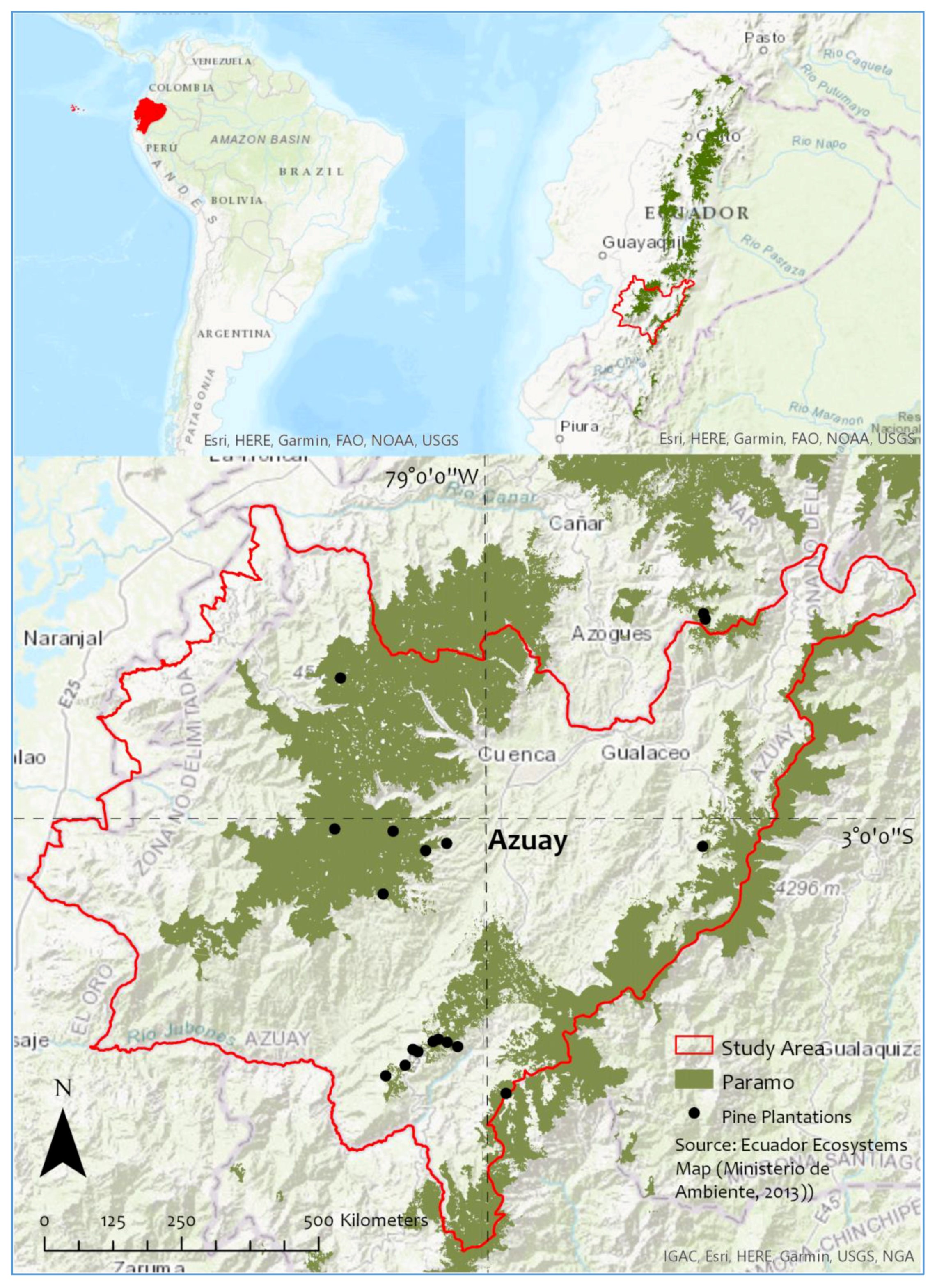
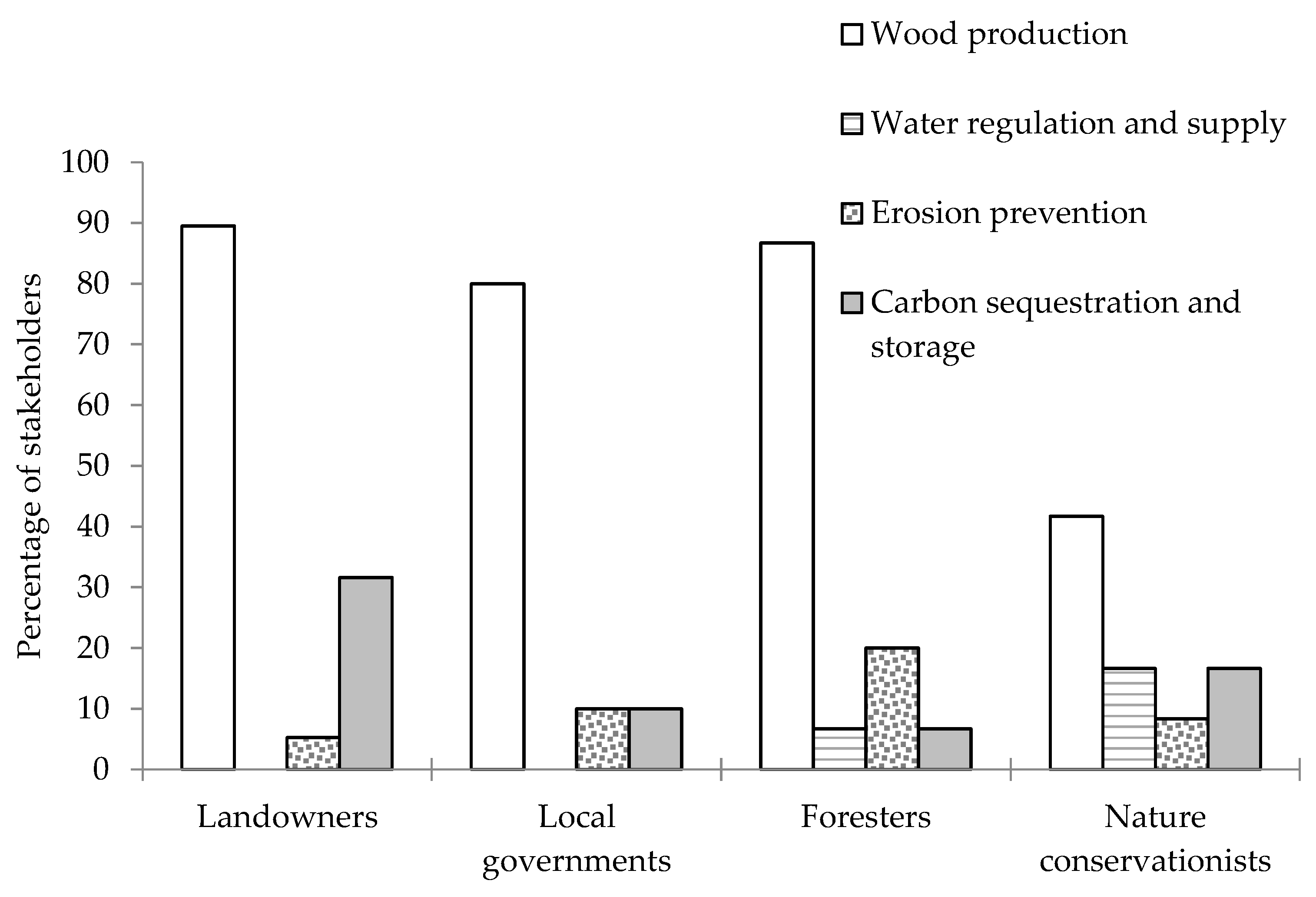
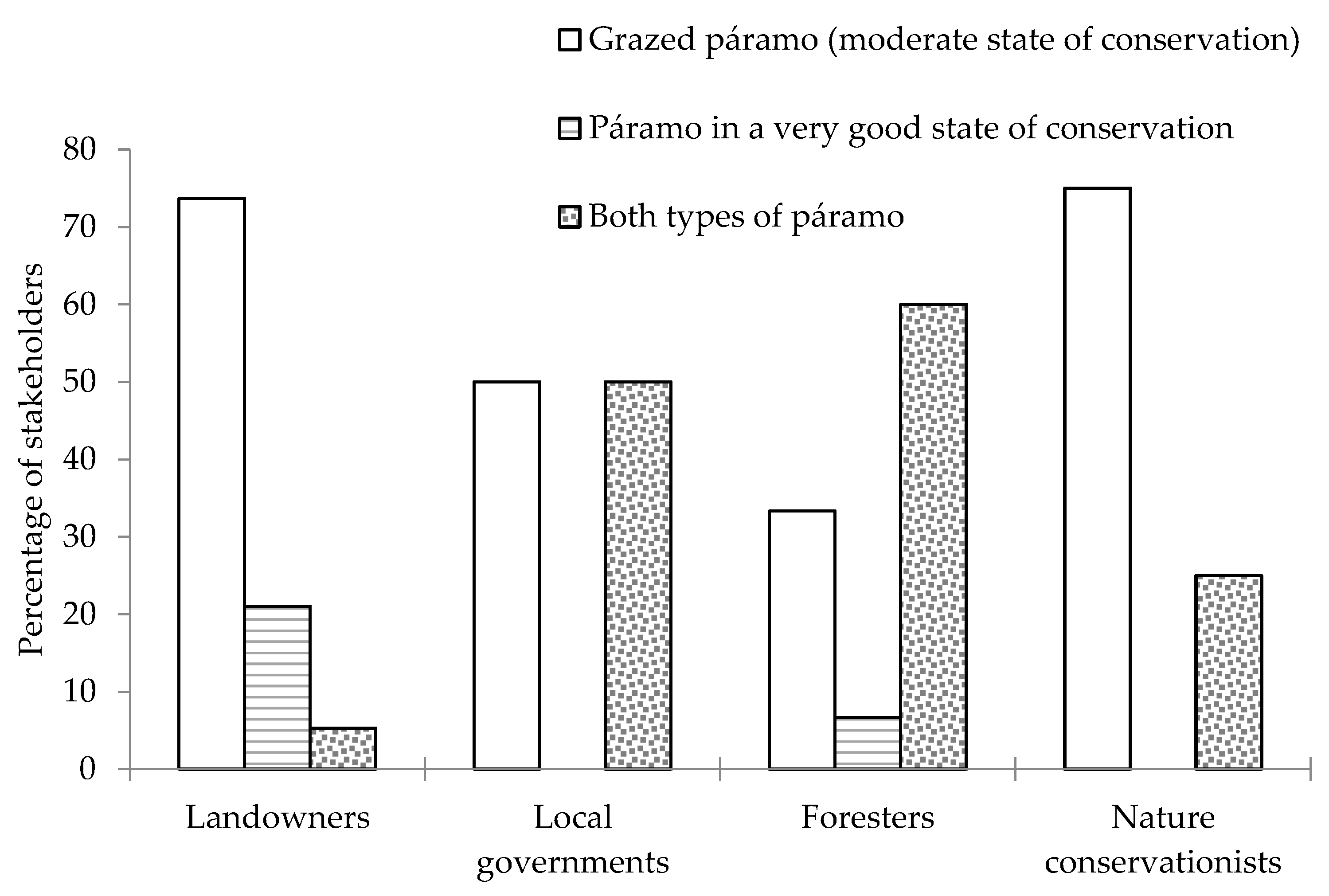
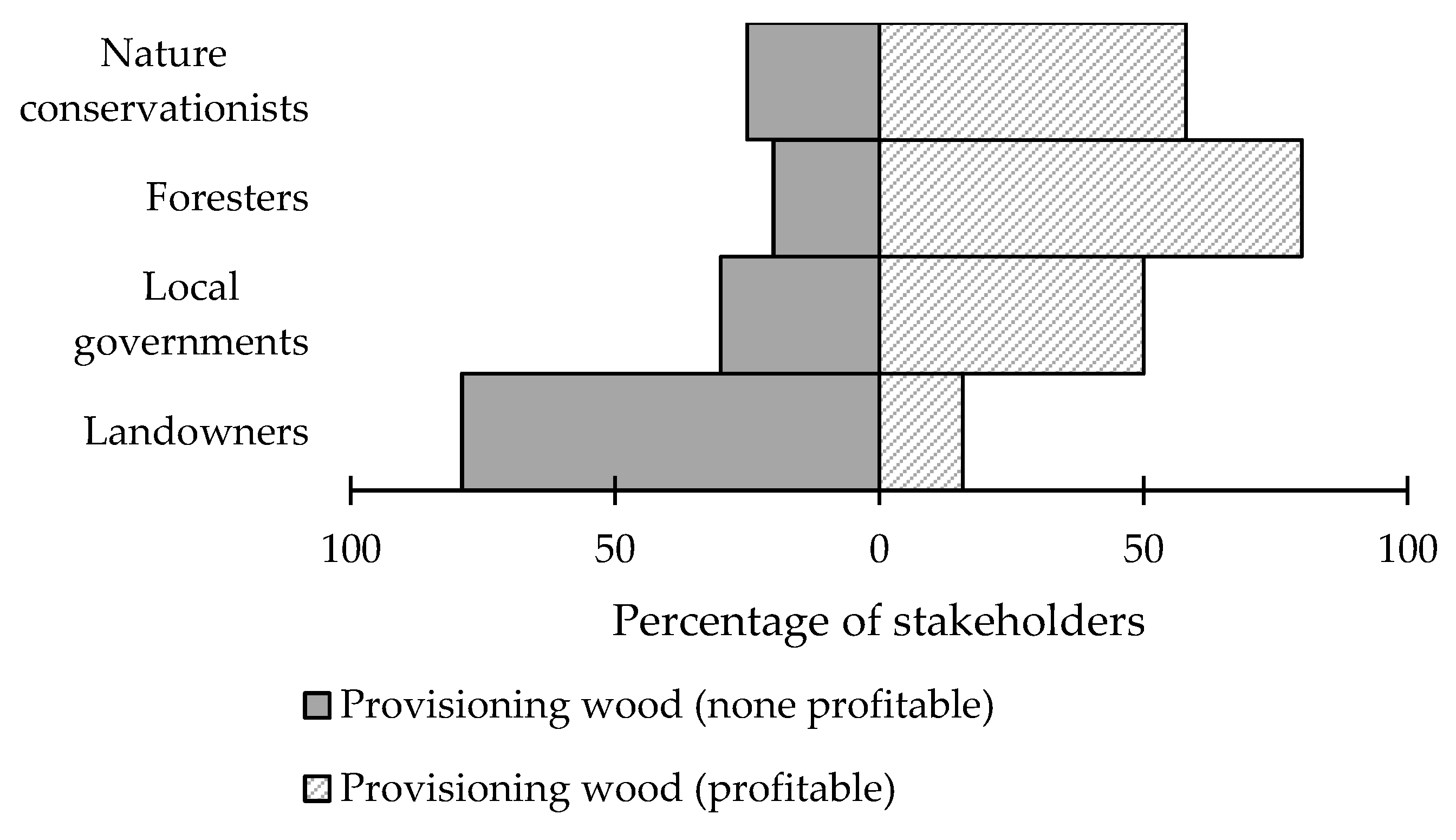
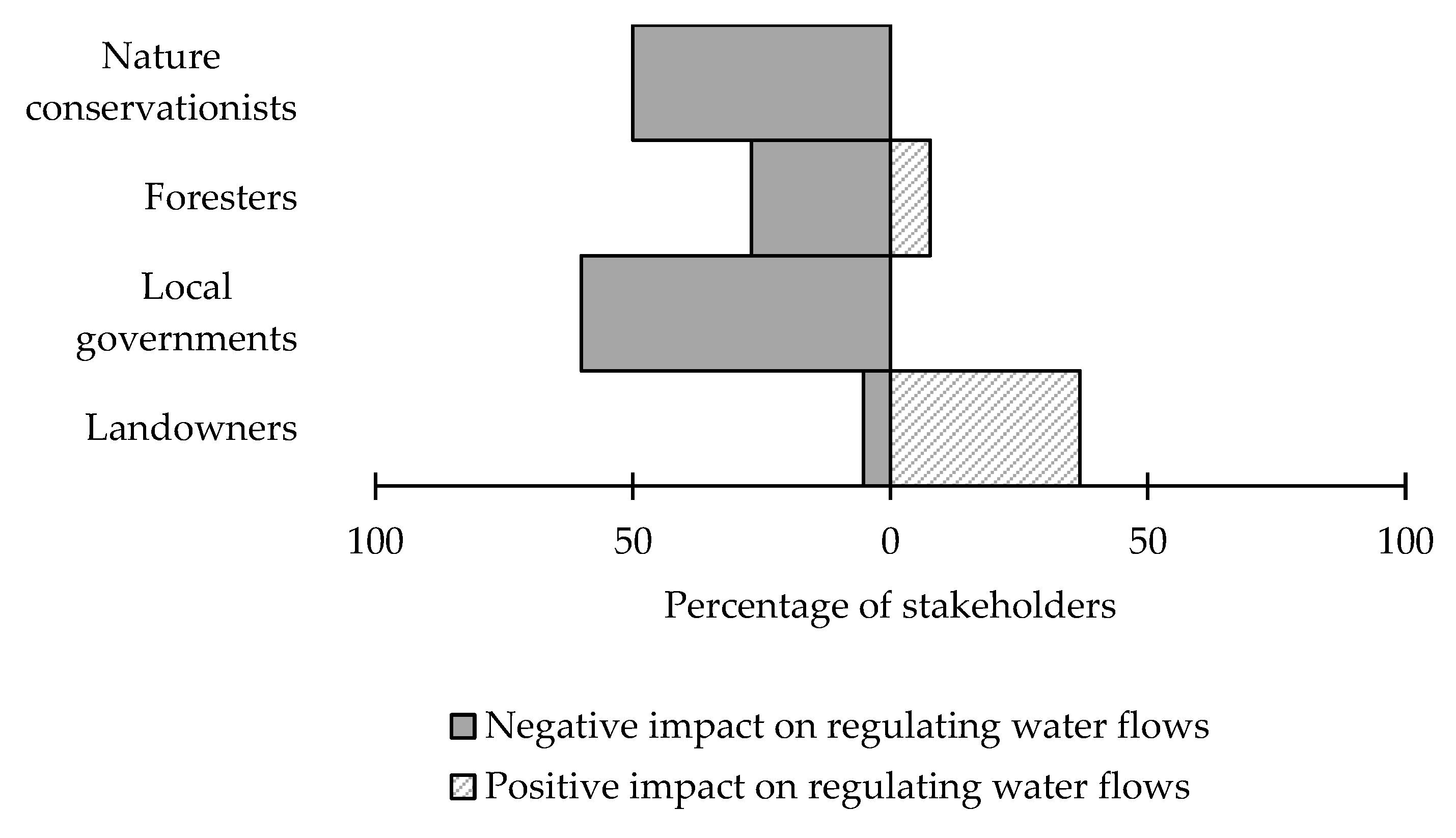
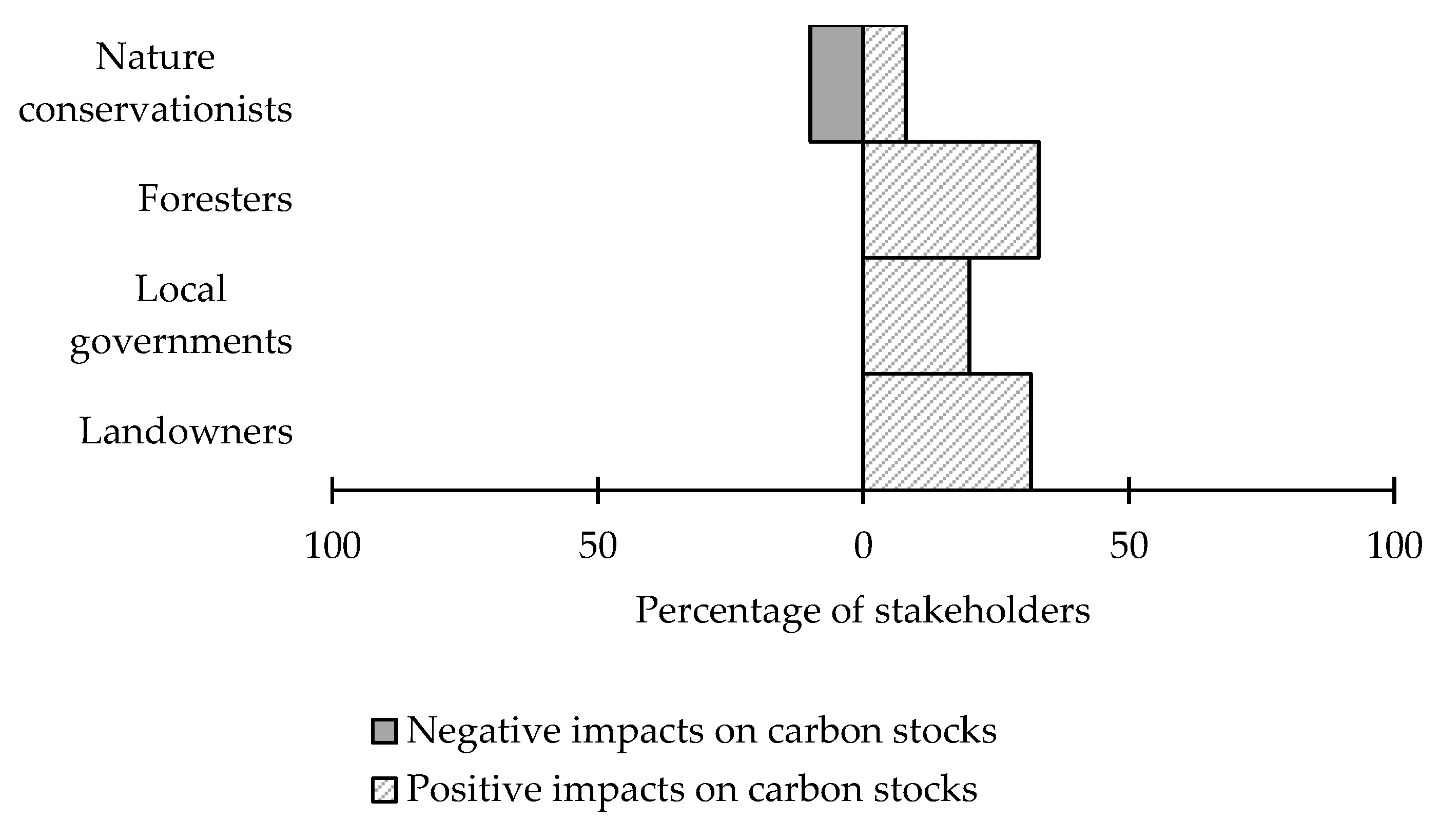

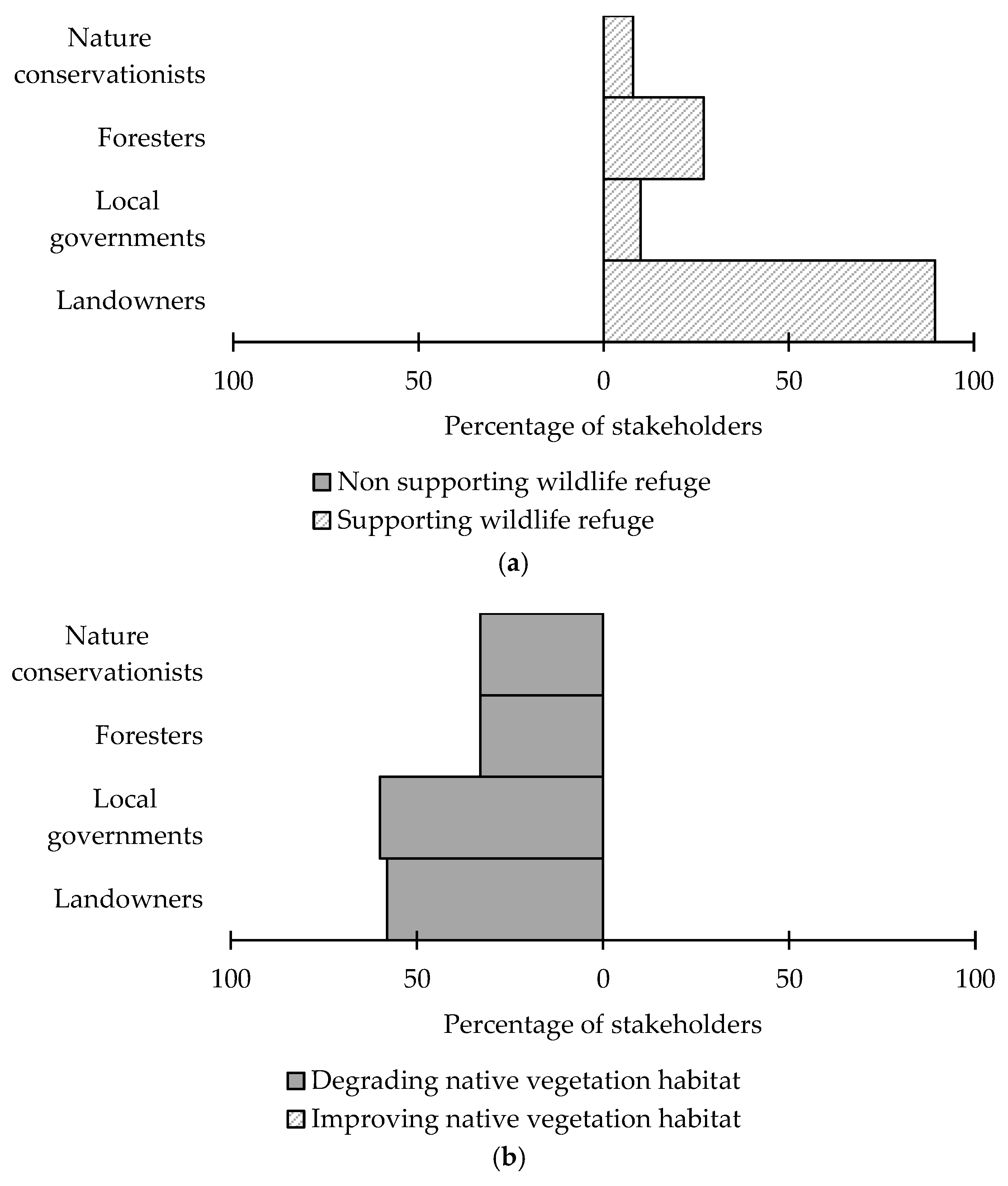
| Stakeholder Classification | Stakeholder | Institutional Level | Environmental Interest |
|---|---|---|---|
| Landowners | Pine plantation owners | Local on-site | Timber production, conservation |
| Local governments | Local authorities | Local | Biodiversity conservation, timber production, and conflict avoidance |
| Foresters | Companies | Local, regional, national | Climate change mitigation, sustainable forestry, advice on the creation and implementation of sustainable forest management policies |
| Forest departments | Local, regional, national | Plantation productivity, sustainable management of commercial plantations | |
| Universities | Local, regional, national | Research, sustainable management of plantations | |
| Wood industry | Regional, national | Plantation productivity | |
| Nature conservationists | Consortium | Regional, national, international | Applied research, information exchange and policy development |
| Corporation | Regional, national, international | Research, training, and technical support of the sustainable management of the páramo | |
| Environmental departments | Local, national | Forestry regulation on protected areas | |
| NGOs | Regional, national, international | Preservation and restauration of ecosystems in the highlands | |
| Private mercantile trust | Local, regional | Research, monitoring, forest restoration, and planting in the highlands | |
| Universities | Regional, national | Research, sustainable management of the páramo |
| Category | Subcategory | Brief Description | Respondents (%) |
|---|---|---|---|
| Provisioning | Raw materiales (wood) | Ecosystems provide a great diversity of materials including wood. | 91 |
| Freshwater | Ecosystems regulate the flow and purification of water. Vegetation and forests influence the quantity of water available locally. | 2 | |
| Regulating | Carbon sequestration and storage | Ecosystems regulate the global climate by storing and sequestering greenhouse gases. Forest ecosystems are carbon stores. | 27 |
| Water flows | Ecosystems and living organisms create buffers against natural disasters, thereby preventing possible damage. For example, wetlands can soak up flood water. Regulation of natural drainage, irrigation and drought prevention. | 45 | |
| Erosion prevention and maintenance of soil fertility | Soil erosion is a key factor in the process of land degradation and desertification. Vegetation cover prevents soil erosion. Soil fertility is essential for plant growth. | 57 | |
| Supporting | Habitat for species (refugium) | Habitats provide everything that an individual plant or animal needs to survive: food, water, and shelter. Each ecosystem provides different habitats that can be essential for a species’ lifecycle. | 70 |
| Cultural | Ecotourism | Ecosystems and biodiversity play an important role for many kinds of tourism, which in turn provides considerable economic benefits. Cultural and eco-tourism can also educate people about the importance of biological diversity. | 4 |
© 2018 by the authors. Licensee MDPI, Basel, Switzerland. This article is an open access article distributed under the terms and conditions of the Creative Commons Attribution (CC BY) license (http://creativecommons.org/licenses/by/4.0/).
Share and Cite
Quiroz Dahik, C.; Crespo, P.; Stimm, B.; Murtinho, F.; Weber, M.; Hildebrandt, P. Contrasting Stakeholders’ Perceptions of Pine Plantations in the Páramo Ecosystem of Ecuador. Sustainability 2018, 10, 1707. https://doi.org/10.3390/su10061707
Quiroz Dahik C, Crespo P, Stimm B, Murtinho F, Weber M, Hildebrandt P. Contrasting Stakeholders’ Perceptions of Pine Plantations in the Páramo Ecosystem of Ecuador. Sustainability. 2018; 10(6):1707. https://doi.org/10.3390/su10061707
Chicago/Turabian StyleQuiroz Dahik, Carlos, Patricio Crespo, Bernd Stimm, Felipe Murtinho, Michael Weber, and Patrick Hildebrandt. 2018. "Contrasting Stakeholders’ Perceptions of Pine Plantations in the Páramo Ecosystem of Ecuador" Sustainability 10, no. 6: 1707. https://doi.org/10.3390/su10061707
APA StyleQuiroz Dahik, C., Crespo, P., Stimm, B., Murtinho, F., Weber, M., & Hildebrandt, P. (2018). Contrasting Stakeholders’ Perceptions of Pine Plantations in the Páramo Ecosystem of Ecuador. Sustainability, 10(6), 1707. https://doi.org/10.3390/su10061707





